This gorgeous gluten free Challah Crown is definitely a show-stopper, and it’s not difficult to make! Really. Just make sure you’re not using a dry, gritty, rice-based flour — so it’ll hold together!
It’s another recipe where my award-winning gfJules Gluten Free Flour really shines because it’s so fine and light, but it also adds stretch to doughs like this, allowing you to actually braid gluten free bread dough!
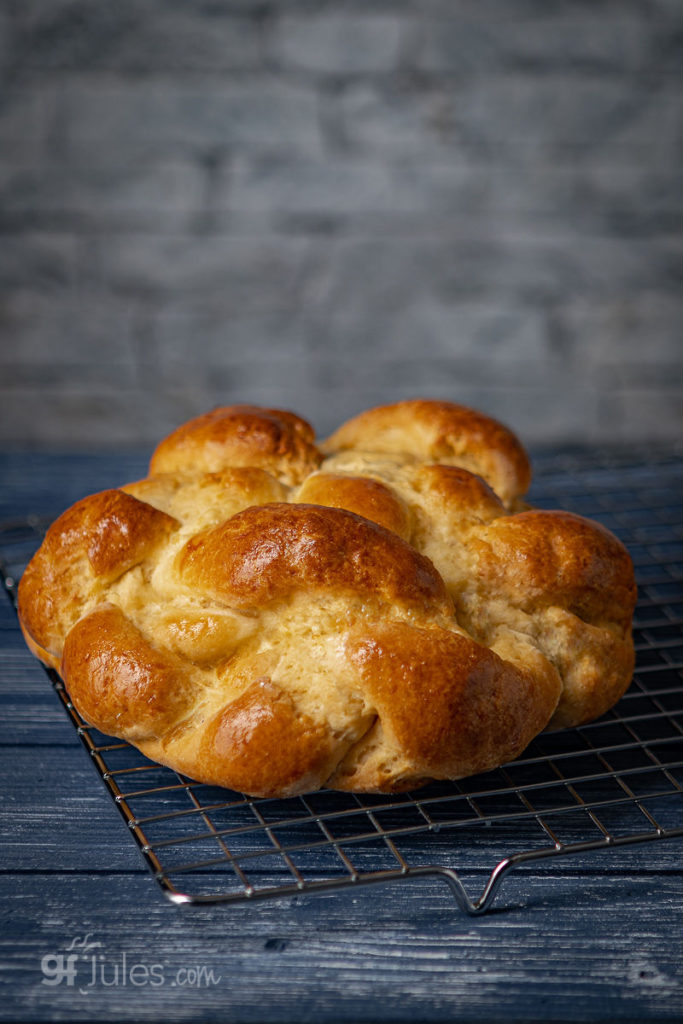
Yes, you read that right: YOU CAN BRAID THIS GLUTEN FREE CHALLAH! It’s all about the gluten free flour, people.
My award-winning gfJules Gluten Free All Purpose Flour is the secret ingredient to making this gorgeous loaf. Now you know.
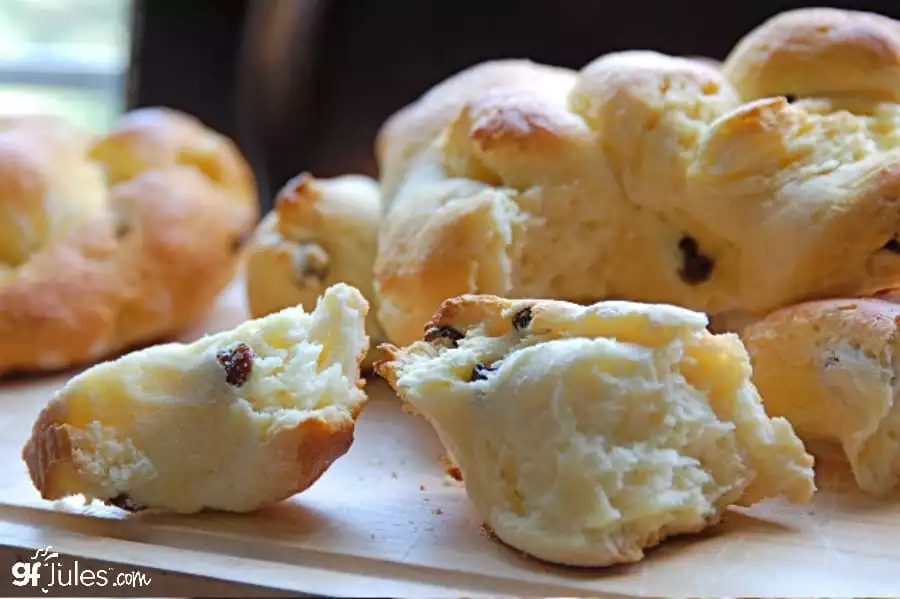
Although associated with important Jewish holidays like Rosh Hashanah (the Jewish New Year), Yom Kippur and Hanukkah, challah is not only a culturally significant bread at these times of year, but is also a delicious and impressive bread to serve at your table any time.
We had friends over last weekend and I served these yummy round loaves because it’s one of our family’s favorite bread recipes, but it also happened to be the days leading up to Rosh Hashanah. They were blown away by my gluten free challah, having made their own GLUTEN-FULL challah the week before, and not loving the results.
It’s true folks: gluten free bread can be better than gluten bread. It happens all the time with my gfJules Flour. I have a whole tab of recipes dedicated to homemade gluten free bread recipes that are arguably better than — or at least as good as! — their gluten counterparts and are certainly quicker and easier to make!
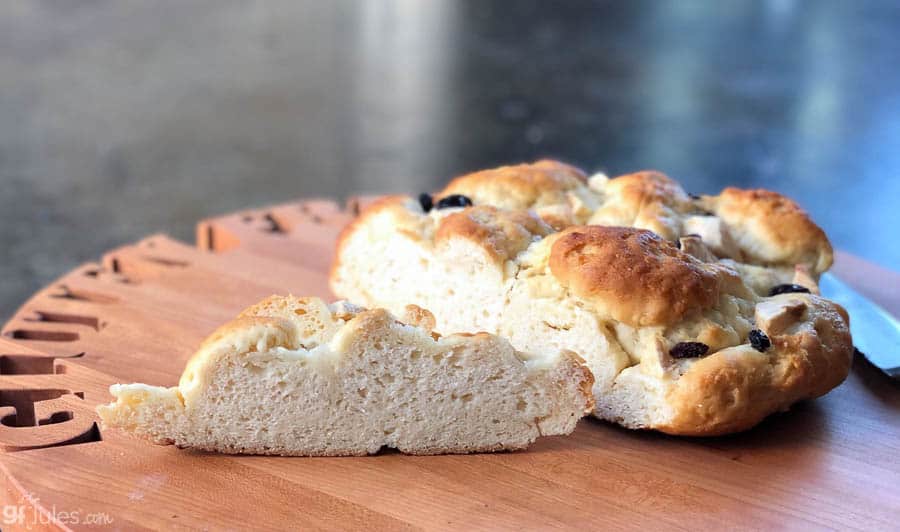
At Rosh Hashanah, challah takes on symbolic importance for those of the Jewish faith who partake of this honey bread as a representation of the sweet new year we all hope for. Add in the extra sweetness of raisins, and dip a piece of the braided bread in high quality honey, and it is even more fun to wish for sweet things in the coming year.
The challah is formed into a round shape at this time of year to symbolize the circle of life and the cyclical pattern of the seasons that shape a year. At Hanukkah (the Festival of Lights), challah feeds the body and the soul, as families gather over the course of 8 days to light the Menorah, savor wonderful meals together, and to exchange gifts in celebration.
To see this bread in braided loaf form, hop to this recipe.
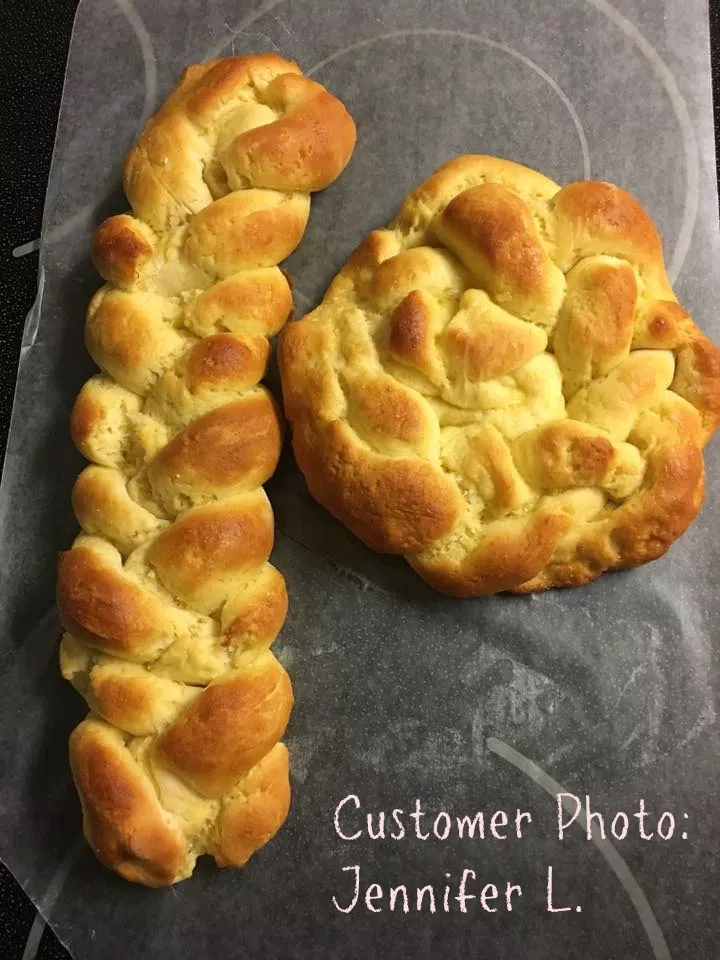
All of you who have seen me at gluten-free cooking classes or demonstrations making yeast breads already know the dirty little secret about gluten-free bread. Shhhh…. don’t tell the gluten-eaters! Seriously!
The secret is that compared to making gluten breads, it is super quick and shockingly easy to make homemade gluten-free bread! Impress your friends and shock the neighbors with this recipe too: not only is gluten-free challah delicious and fast, it’s almost too beautiful to eat!
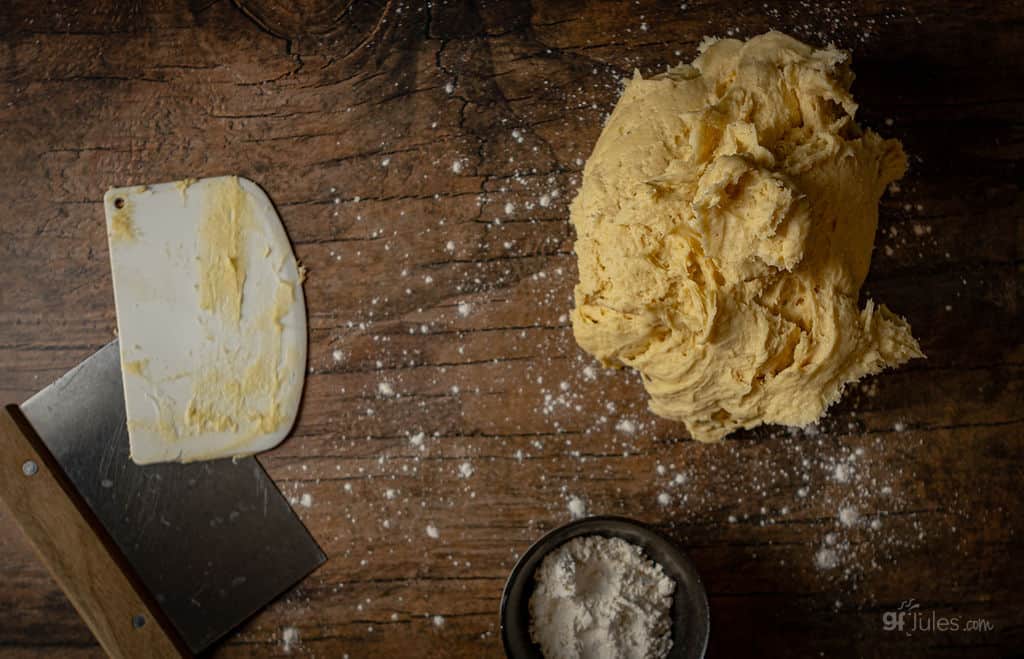
The dough starts out thick and sticky, but rolled in a light dusting of my gfJules Flour, it’s easy to form long strands to braid.

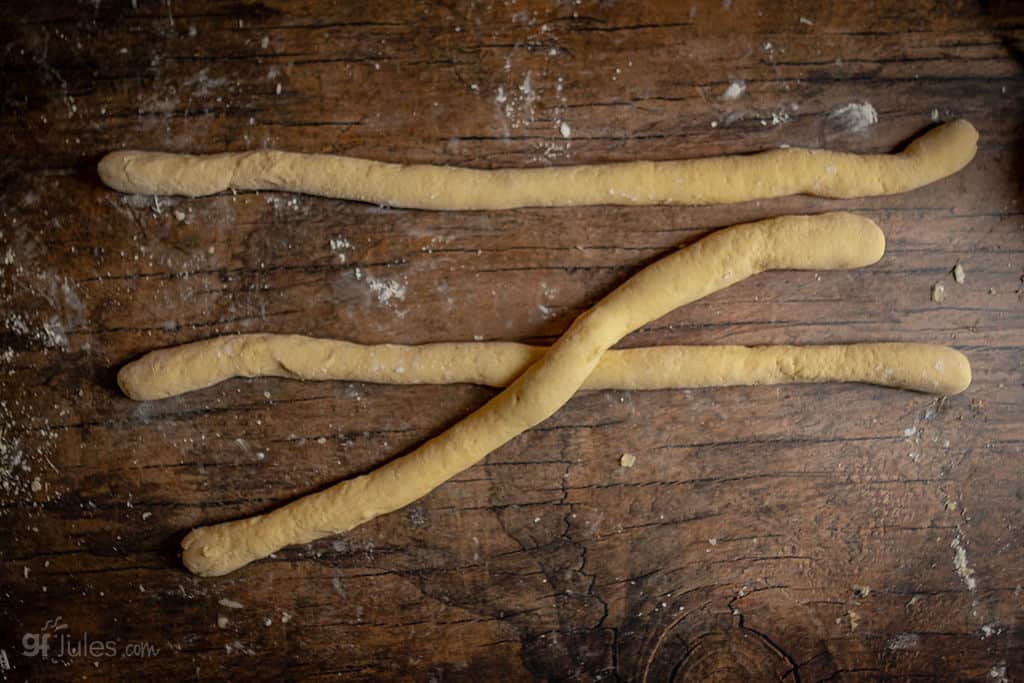
The final ball twist is stunning.

Then brush with egg wash to help keep the dough soft and moist and for that luscious golden color.
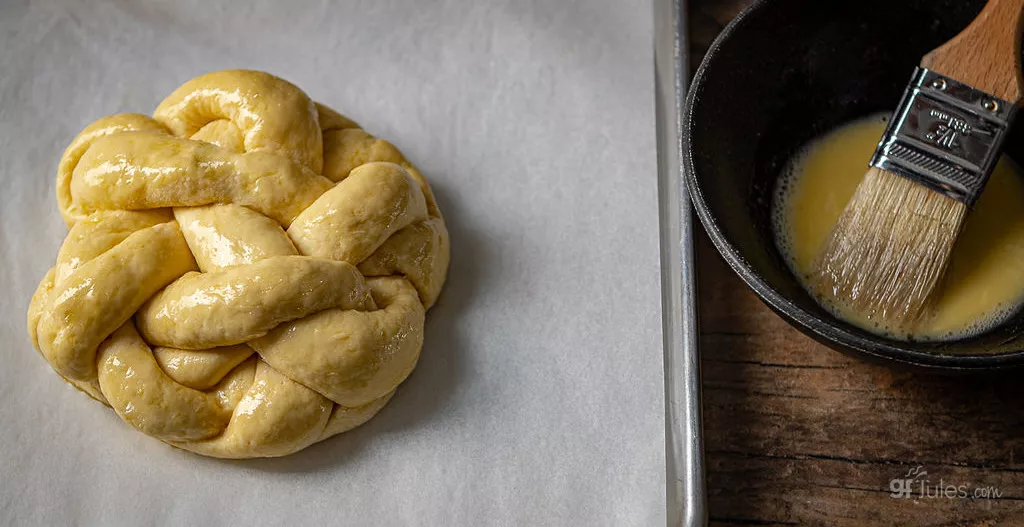
And of course, once baked, it’s hard to resist!

Hamotzi & Baking with a Challah Mold
If you’re looking to make this gluten free challah crown hamotzi (made from the five species of grains — wheat, barley, rye, spelt or oat — oat being the only one that is gluten free) by using 51% oat flour, I would recommend using a molded challah pan since it will be more difficult to braid without using all gfJules Flour.
I have heard from readers that even at only 49% gfJules Flour though, they have been able to braid this dough, just not quite as easily.
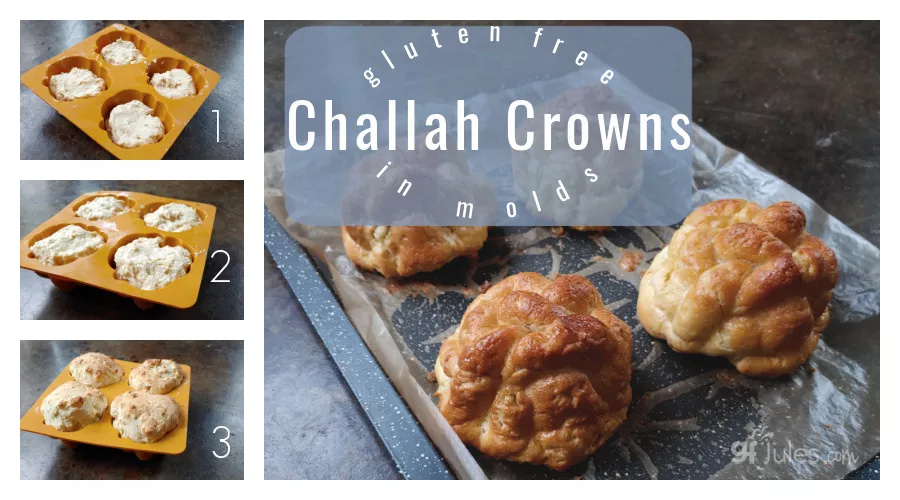
2) rise in pan
3) bake 15 minutes in pan then turn out to bake 5 minutes on baking sheet
If you do choose to use a molded challah pan, you may have too much dough for the pan, so plan to put the extra dough in a loaf pan or even in muffin pans to make extra rolls with it.
Incidentally, I make my own gluten free oat flour when I do use oat flour. It’s super easy to do and that way you can use purity protocol oats which are easier to find in full oat form than in oat flour form.
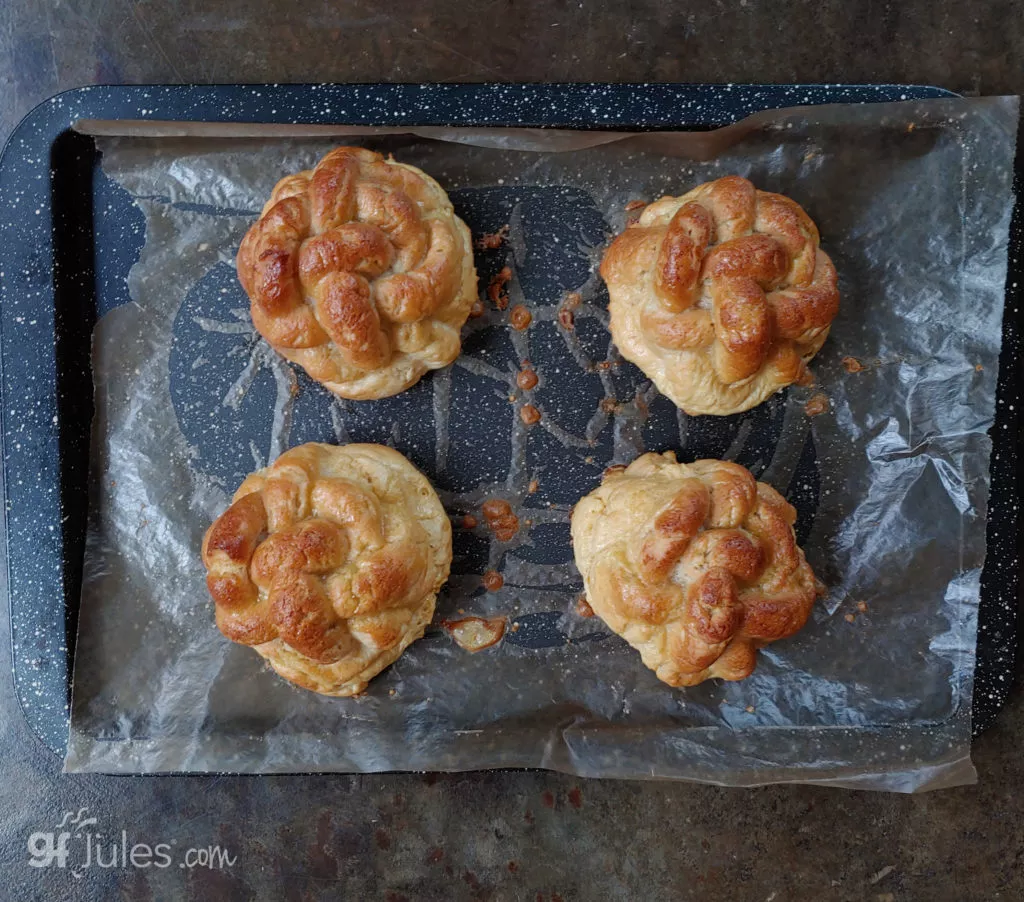
No matter what your reason for making this delicious bread, celebrate that this impressive recipe is at your gluten-free fingertips any time you feel like having a sweeter day.
Gluten Free Challah Crown Recipe

Gluten Free Challah Crown
Ingredients
Gluten Free Challah Bread Ingredients
- 1/2 cup + 2 Tbs. warm water
- 1 Tbs. gluten free yeast like Red Star -- not platinum! -- or Fleishmann's
- 1 tsp. granulated cane sugar
- 1 cup vanilla dairy or non-dairy yogurt at room temperature (So Delicious® Vanilla Coconut Yogurt)*
- 2 tsp. apple cider vinegar
- 5 large egg yolks at room temperature slightly mixed**
- 1/3 cup sunflower oil OR non-GMO canola oil OR extra virgin olive oil
- 4 Tbs. honey OR agave nectar OR maple syrup
- 4 cups (540 grams) gfJules™ All Purpose Flour
- 1 Tbs. psyllium husk powder (added for smoother texture, but if not using, reduce total water by 2 Tbs.)
- 3 Tbs. + 2 tsp. granulated cane sugar
- 1 1/4 tsp. kosher salt
Toppings
- 1 large egg mixed
- poppy seeds sesame seeds, raisins, diced apples or other toppings or mix-ins (optional)
Instructions
- Preheat your oven to 200º F, then turn it off; if you have a warming drawer, you may set that to low/moist setting instead. Prepare a baking sheet by lining it with parchment paper.
- In a small bowl, mix together ~1/3 cup (5 Tbs) warm water, yeast and 1 teaspoon of sugar to prove the yeast; set aside.
- In the bowl of your stand mixer, add the remaining wet ingredients (remaining 5 Tbs water, yogurt, cider vinegar, egg yolks, oil, honey) and mix until combined.
- Whisk together the dry ingredients in a separate bowl (gfJules Flour; psyllium, 3Tbs + 2 tsp. sugar; salt).
- After 5 minutes of proofing, stir in the bubbling yeast-water mixture into the wet ingredients (note: if your yeast isn’t bubbling at this point, throw it out and start again with fresh yeast).
- Gradually stir the dry ingredients into the wet until fully integrated, adding more warm water by the tablespoon only as needed to get the dough soft and so that the dough is not tight or stiff — you should be able to pull the dough gently without it feeling tight or like it would bounce back — if it’s stiff, add more warm water then mix 1-2 minutes more on medium speed to integrate the additional water. The dough should be workable; keep in mind you will be braiding it, so it can't be too loose or too tight (think of Goldilocks dough!)
- Once the dough is combined, divide it in half and divide each half into three equal-sized balls. The dough will be sticky, so use extra gfJules Flour on your hands and rolling surface (I like using a bench scraper like this one to help me cut and roll the sticky dough).
- Roll each ball out into an 18-inch coil or log on a clean, flat surface dusted lightly with gfJules Flour. If you have trouble rolling because you've used too much flour, dab a bit of water onto the counter or mat.
- Pinch together one end of each coil, wetting them slightly with water to help them join together at the top, then braid them, finishing by connecting them to the top of the other end in order to form a crown, or circular shape, or simply leave as a long braid.
- Gently transfer to the parchment-lined baking sheet. Repeat for the second set of three balls. In the alternative, you can simply divide the dough in half, roll out into a flattened coil, then twist the coil upon itself and join at the ends to form a circular loaf; repeat with the other half of the dough ball.
- In a small bowl, mix the extra egg (at room temperature) together and brush over each loaf, coating the entire surface. Sprinkle the seeds or any toppings at this point, then place the tray (covering the loaves with wax paper sprayed with cooking oil) in a warming drawer set to low heat, or into a warm location for 20 – 30 minutes. (Don’t expect the bread to rise much at this stage).
- Once risen slightly, place the uncovered tray in an oven preheated to 350º F (static) or 325º F (convection) for 20 minutes or until a toothpick inserted into the center of the bread comes out dry, or with some crumbs attached but no wet dough.
- Remove to cool on a wire rack.
Video
Notes
** Please keep in mind that nutrition information provided is per serving, which may vary. While we have taken care to provide you with the most accurate nutritional values possible, please note that this information may differ significantly depending on the exact ingredients and brands that you choose to use to make this recipe. Additionally, where options are given for ingredients, the resulting calculation may include all ingredient options instead of only one per line, skewing the totals significantly.
Pin it for later!
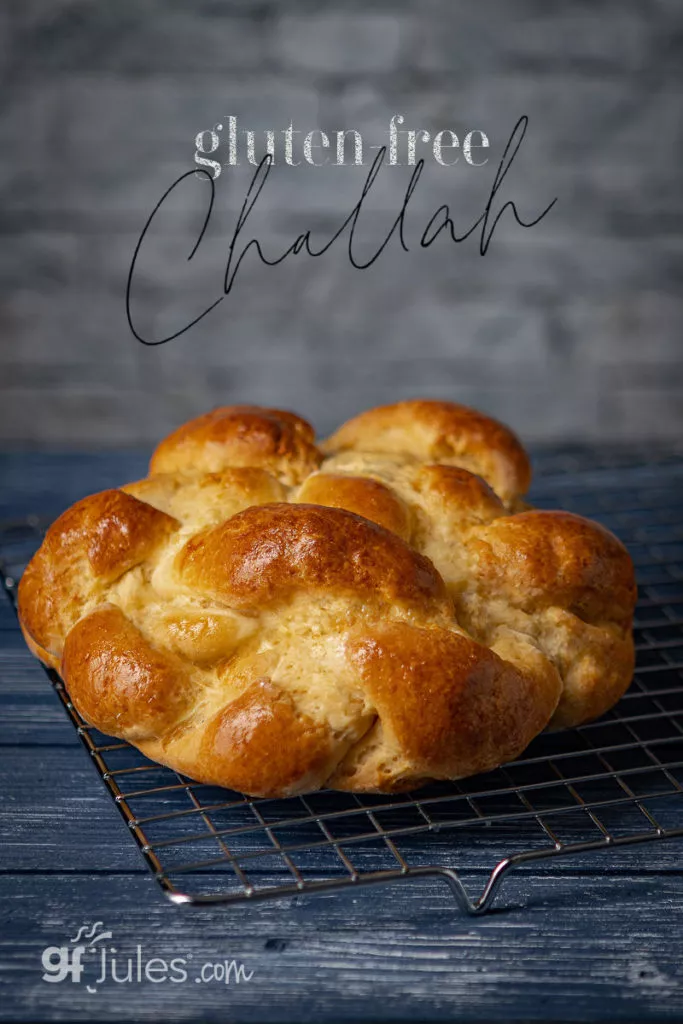

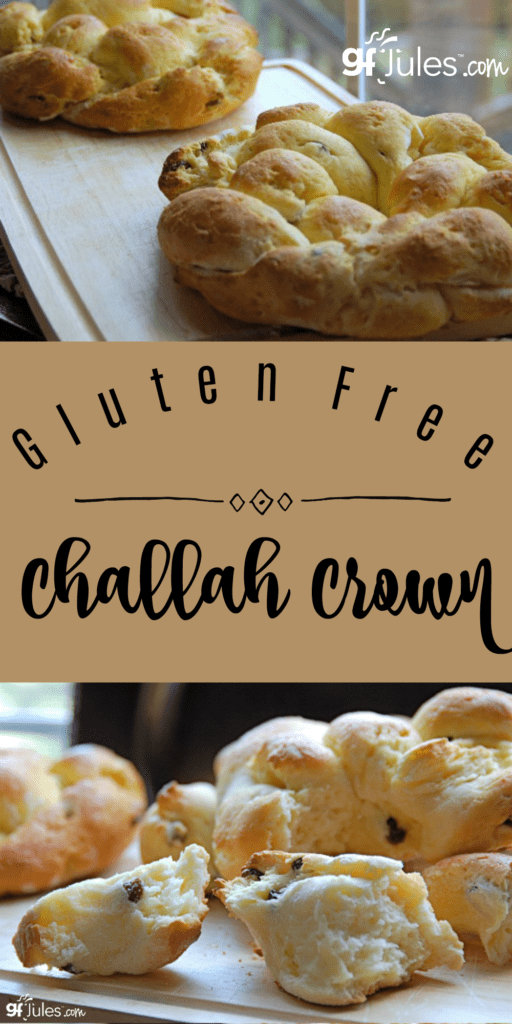

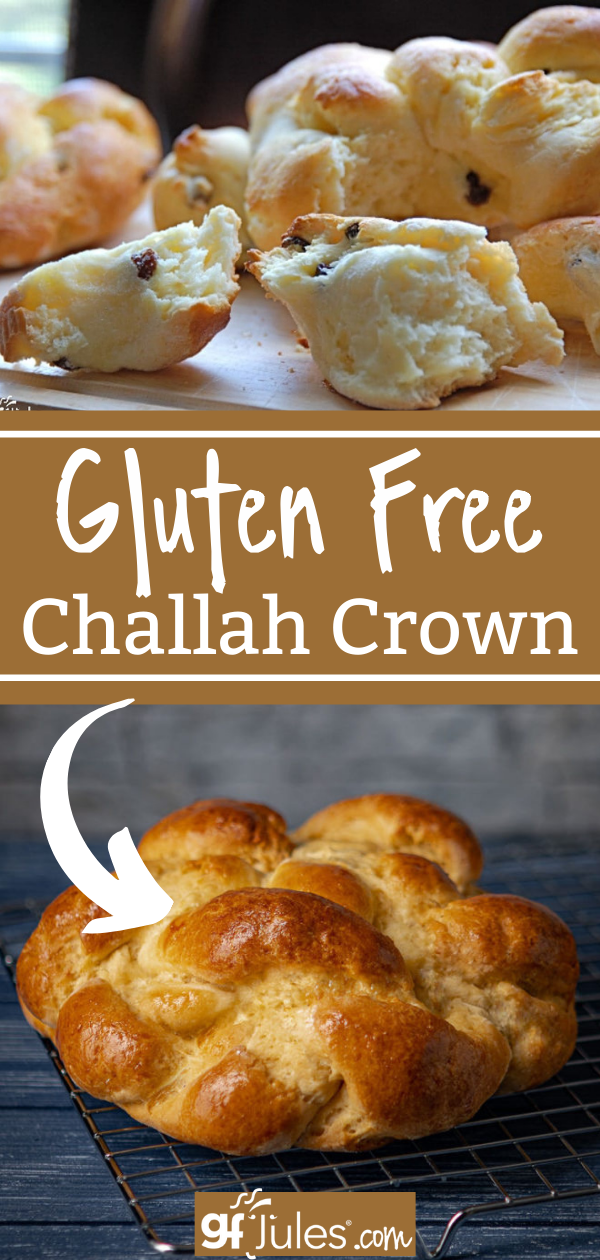





 Based on 33 Review(s)
Based on 33 Review(s)













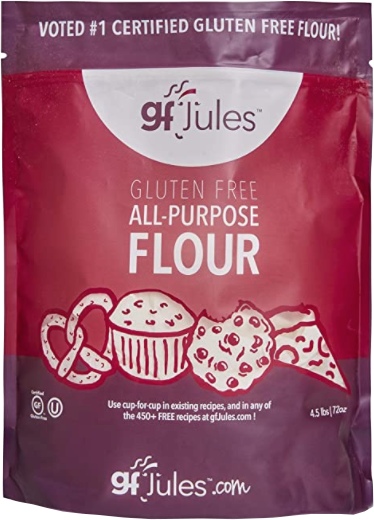
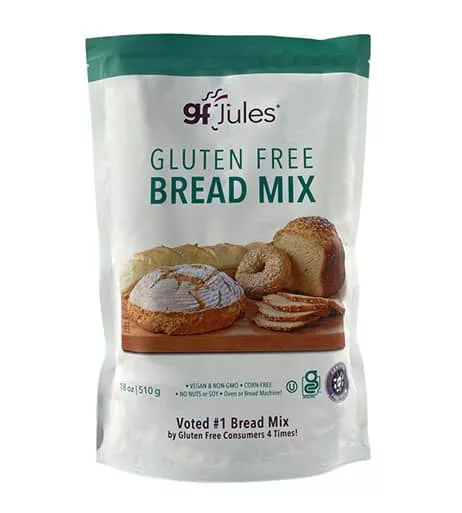
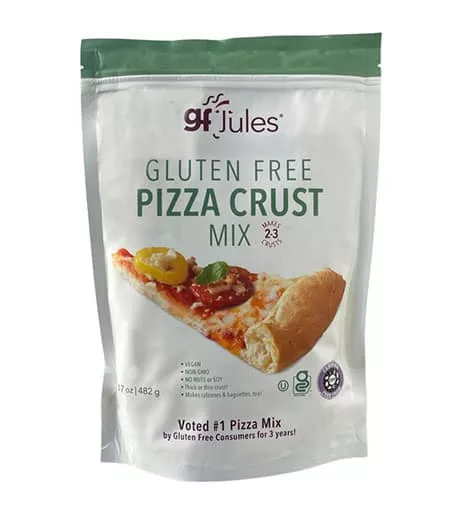
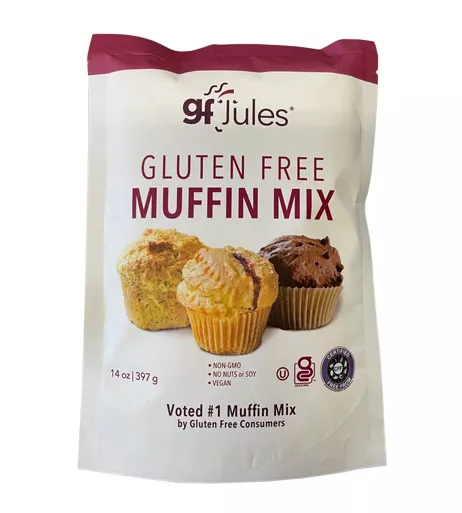


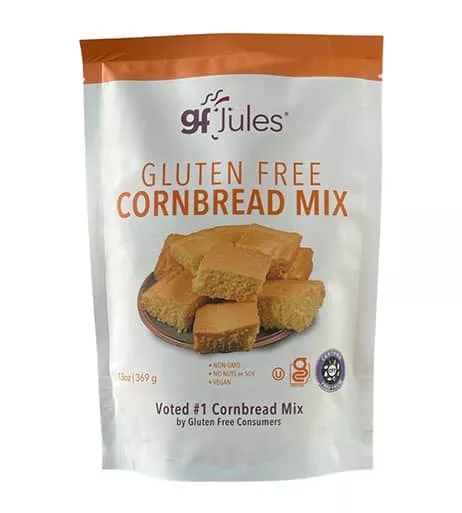



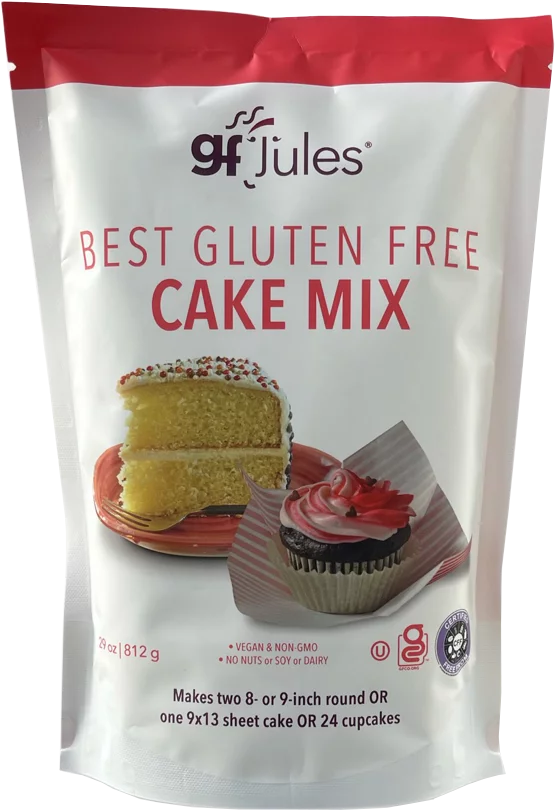

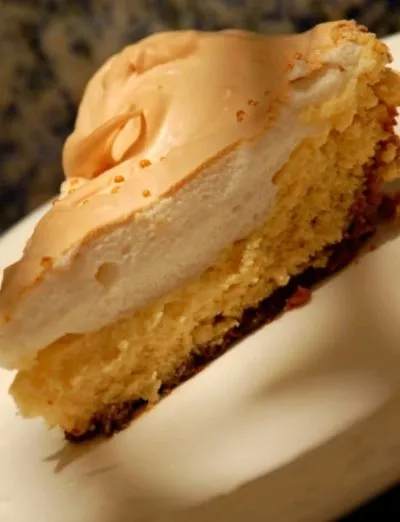
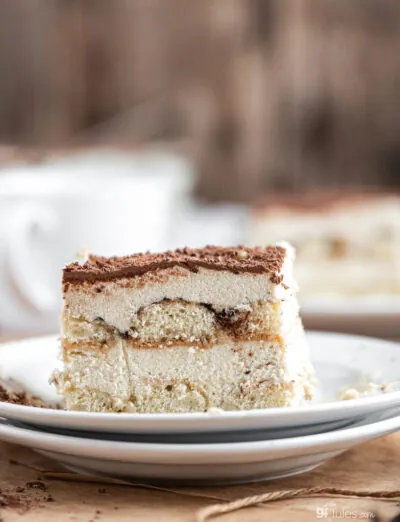
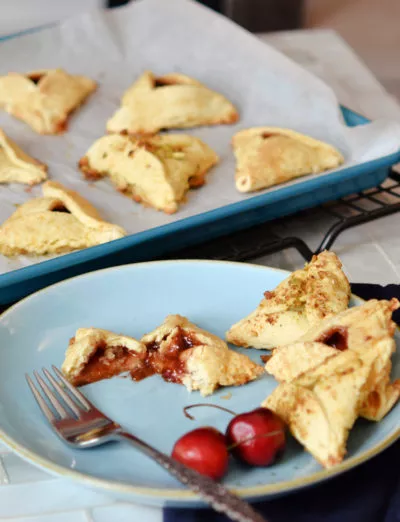


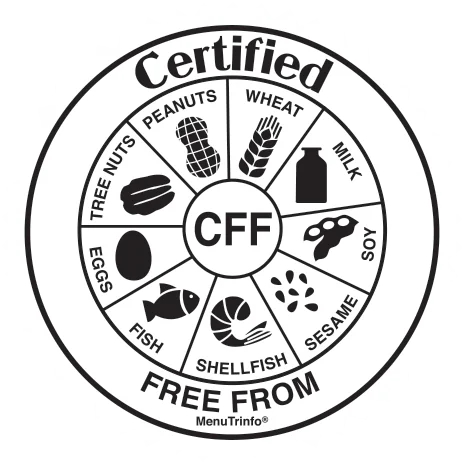
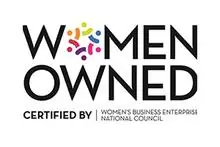

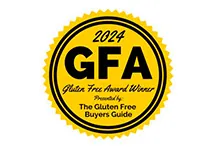
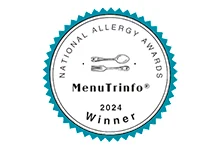
I can’t wait to make the challah for my family BUT one of my grandchildren is allergic to eggs, gluten (no problem) and yeast. Any suggestions?
Hi Lynn, I would ordinarily not recommend substituting eggs in a recipe like this since it’s an “egg bread,” but there have been some advancements in egg substitutes lately, and they’re worth a try if you’re up to it! Take a look at my article on egg substitutes and focus on the ones recommended for egg yolks. https://gfjules.com/egg-free-vegan-baking-tips/
Vegan mayo, aquafaba, flax egg and some commercial egg subs — some combination might just do the trick!
~jules
Hi Jules. Could I use this to make, dry and make an overnight frenchtoast casserole? Me grandson is gf and coming for Thanksgiving. He used to love the gluten kind but since needing to be gf, we haven’t found a bread that is sturdy enough. Thx for your help
Hi Vickie, absolutely! I’ve made my overnight French Toast Casserole with this gluten free challah many times — it’s delicious!!
~jules
A few days ago I attempted your Crown Challah recipe but did not have your flour on hand. I used the following substitutions and proportions based on what you suggest on your website: 135g brown rice flour, 135g almond flour, 202g potato starch and 68g corn starch. Once mixed the batter/mixture was extremely sticky so I added an extra 1/3 cup almond flour. I also used 4tsp Xanthan gum as you suggested 1 tsp for each cup of flour. I was unable to handle and shape the challah so I used 1/3 cup measuring cup and made 2 round challahs in a 9in baking pan with a central roll and 8 rolls around it. I added raisins in both and topped the one with chocolate.
They rose nicely and baked beautifully and were so much like the challahs that we have been missing.
I seems that my choice of flours/starches did not absorb the liquid ingredients. Since we loved the flavor, how can I continue to use the current flour starch combination? Should I use different flour that requires more hydration? Use less liquid. Use a mould although the circle or rolls was great. Use psyllium instead of Xanthan gum? Optimally I would so love to be able to braid the challah.
I see you use modified tapioca starch in your flour. I suppose I could add some Expandex to the mixture.
Look forward to your comments and thank you so much for sharing this wonderful recipe.
This recipe is soooooo sticky. It works well but I had to add almost a cup more flour while shaping just to make it workable, and that was without the remaining water in the wet ingredients! Makes the closest thing to challah I’ve had though
Is there an appropriate substitute for the sugar in this recipe (both for proofing the yeast and as part of the dough)? Perhaps a specific amount of honey instead?
Hi Terry, you could use honey for proofing the yeast, yes. The other amount of sugar can be cut some and if you want to substitute with a liquid sweetener like honey, you would need to adjust the liquid proportions in the recipe as well, so note that you will be adding a bit less liquid to account for that. The dough may also be a bit flatter with the reduction of the granulated sugar, but it should still turn out well enough for you. Enjoy!
~jules
Can you make suggestions for using a bread machine on “dough” cycle? I do not have a stand mixer. Also, would “bread machine” yeast work instead of the wet yeast you include here? Thanks – can’t wait to try this!
Hi Cheryl, you can absolutely use a bread machine’s dough cycle to mix the dough for this challah recipe. Most any bread machine that has a dough cycle should work for that. As for yeast, bread machine yeast is a good sub for the instant yeast I use in this recipe, as would standard yeast. Here’s a link to an article on yeast which goes into more detail about the differences in yeast so you know what changes you might need to make, depending on what you end up using. Enjoy the recipe!
~jules
Hi! I tried making this challah today. It tastes delicious but did not rise very much. I used my bread machine to make the dough and put the wet ingredients in first, then added the blended dry ingredients. I’m wondering if I should have simply added the yeast without proofing it with the water and sugar? Normally when I make a bread dough recipe in my bread machine, I just add the yeast dry. Thank you.
Hi Adrienne, it’s possible that would have made a difference in this case, but the thing I find that makes the most difference with this particular recipe is really mixing the dough slowly while adding the liquid, which is hard to do using a bread machine. If the dough is too “tight” it won’t be able to rise, so it’s important to add enough liquid, and even the humidity and altitude can make a difference. Next time if using your bread machine to mix the dough I think what I would do is maybe use 3 whole eggs and 1 egg yolk. If you are able to watch your machine while it’s mixing, I would stand at the ready with another 1/4 cup of warm water as well and be prepared to slowly add more water by the tablespoon if you feel like the dough is still taught or tight. It can’t be too loose to braid, but if it’s too taffy-like and tight, it won’t be loose enough to rise. This is where I would start and see if that does the trick.
Please come back and let me know if this is helpful or if you do anything else differently that seems to help. This recipe is truly worth any and all effort, so I hope it works!!!
~jules
Hi! I’m going to try this again – I’m on my 4th attempt! My biggest issue is that it does not rise. My husband calls it ciabatta challah! With my most recent attempt, I did not use my bread machine but made it exactly as written. I’m wondering if I should use my dough paddles to mix the dough instead of the regular mixers. Also, how long in total should the dough mix in the stand mixer? I want to make sure I’m not either over or under mixing it. Any other tips to get it to rise properly? Thank you!
Hi Adrienne – I love your husband’s upbeat humor! And I love that you’re not giving up!
Assuming you’re using all the ingredients as listed, and assuming they’re all at room temperature, I would not use the regular mixers or the bread machine. I do use a stand mixer with the paddle attachment. Make sure the dough is loose enough to rise — that is the biggest issue I’ve seen with this recipe when it won’t rise; the dough is just too tight/stiff so it can’t rise. While mixing, make sure it’s not like taffy consistency. If you need to add a bit more water or yogurt to the dough to get it to be looser so you can imagine it having stretch to it, add a bit more liquid. You’ve got to still be able to braid it (and don’t braid it too tightly so there’s room for the rise) so it can’t be WET, but it shouldn’t be like taffy either. You should mix for about 3-4 minutes. Once it’s braided, cover it with parchment and set it aside to rise — it should definitely do some rising at this point and it will rise more in the oven. If you have a convection setting on your oven, that often gives breads even more encouragement in the rising department!
Ok, hopefully those tips will help – let me know how it goes!!!
~jules
Thank you! I’m trying again tomorrow and will let you know! 🙂
SUCCESS!!!
YAY! That’s what I love to hear! Congratulations!
~jules
Thanks! It’s still not perfect (yet!) but I do have a good idea of how the dough should feel and am tinkering with the size and shape of the pan to keep the dough from spreading too much.
Great – if you bake a loaf every Friday, you should be a pro quite soon and be able to teach me a thing or two! Be sure to share any tips so we can all learn from each other! That’s the true beauty of baking bread, I think, as there are little tweaks and tricks that can make big differences! Happy baking!
~jules
Hi! So last week I put the braided loaf in a glass bread loaf pyrex dish in the hopes that it would rise a bit more and it did! It obviously has a more rectangular shape but it rose much higher than prior attempts. We haven’t tried making french toast with it yet but that’s the goal. This week, however, is a round challah and I will need to find a smaller, round baking dish so it will rise appropriately. I will keep you updated! We are also going to try the cinnamon roll recipe!
So glad to hear it, Adrienne! Thanks so much for letting me know!!!
~jules
Jules,
Did I see somewhere that you said you could make the bread, let it rise then cover it and refrigerate until the next day, let it come to room temp & bake?
Hi Pat, it’s definitely possible with any of the yeast bread recipes. It slows the activity of the yeast overnight to refrigerate it; I wouldn’t let it rise all the way, as it will still rise some overnight. But yes, cover well to keep it from drying out and then let it come to room temperature and then brush it with egg wash or milk then bake it. Enjoy!
~jules
Has anyone tried this recipe using an egg replacer?
Sounds wonderful! Do you know if it freezes well? I’d like to prep for xmas ahead time.
Thanks!
Yes it does freeze well if you squeeze all the air out of the bag and freeze when totally cooled. I like to bring it slowly to room temperature or wrap in foil and gently heat in a warm oven. Enjoy!
~jules
Does your Jules flour have potato starch as an ingredient?
Hi Sandra, yes it does. You can find the ingredients to each of my products on their product page under the “ingredients” tab. Here’s the link to my gfJules Flour.
~jules
My 17 year old daughter recently went gluten-free as part of aLow FODMAP diet and although she does not have Celiac’s (my sister-in-law does) she doesn’t tolerate gluten at all. Our Jewish lineage is very important to us and giving up Challah had been extremely upsetting for her so I was intrigued and grateful to find this recipe. I’m a very experienced and accomplished ametuer baker but gluten-free baking is VERY different. Thank you so much for putting this recipe online for all to try so that my daughter can still feel she is honoring get heritage and I can learn gluten-free baking.
Hi Heather, thank YOU for taking the time to write me a note and let me know that the challah recipe and how-tos are helpful to you both. Challah is one of the foods that I hear the most about from folks because it is so different to make gluten-free, technique-wise, and it’s so very important culturally and religiously for so many. It was important for me to nail this recipe early on, as I know many dear friends who need a great GF challah recipe! I have two recipes for challah on my site, so be sure to check them both out. I also have videos and of course the how-to photos. I hope that you and your daughter make many wonderful memories of making GF challah together. All the best to you both!
~jules
Me and my 6yr old daughter had great fun making these together! We put flaked almonds on the top. Thank you for the recipe.
The almond topping sounds delicious!!! So glad you both enjoyed making and eating this yummy bread!
~jules
Is a package of yeast 1 small packet or the strip of 3 yeast packets?
Great question, Katherine! I’ve never been asked that before – perhaps I should be making that more clear in recipes. One packet is just one of the square packets of yeast, not 3 of them in a strip. It’s also equal to 2 1/4 teaspoons. Hope that helps!
~jules
Delicious, I actually use this dough for cinnamon and sometimes orange rolls. Its generally easy to work with. Again, where would I be without you and your recipes. My daughter was a freshman in high school when I first discovered you and she is now a healthy first year teacher. Thanks Jules, time flies but you remain my go to flour for the special baked yummies you just cant get anywhere but your own home kitchen,
Oh Chari, that is so sweet of you to share with me. I’m so happy to hear how well your daughter is doing and to feel like I’ve been a part of yours and her success in living gluten free means so much to me! Wishing you both all the best!
~jules
Can I make a smaller loaf using half of each ingredient? Any other adjustments I would have to make? Thanks.
Hi Wendy, yes you could halve the ingredients. There shouldn’t need to be more adjustments. Enjoy!
~jules
To make a gluten free challah that qualifies for a Shabbat bread blessing (hamotzi challah) more than half the flour must be one of the 5 grains. You did not appear to be aware of this, and it important to know when hosting a gluten-intolerant religious guest.
I’ve had great success using oat flour from grinding instant oats in the processor. I add xanthan gum, but I have since learned (aside from flax eggs) you can substitute with pectin.
Posted by: barb@jmark1.com
Some celiacs cannot handle oats – also from what I know oats aren’t one of the Five Grains which are wheat, barley, spelt, rice, or rye, only one of which a celiac could consume.
Rice is not one of the grains over which the bread blessing is said
We attend a conservative synagogue and spoke with Rabbi about gluten free dietary concerns. He said that whenever possible one should adhere to all of the various dietary laws but that it really is OK when food allergies and other health issues prevent someone from following them. Yes, stay kosher, but otherwise it’s ok to make adjustments that will allow everyone to participate.
Thank you for sharing, Heather. I would think that this approach is the one that certainly makes the most sense, however different Rabbis certainly have different opinions on the matter. I hope you can enjoy this amazing recipe!
~jules
I am an orthodox Jew who usually does not eat gluten because of an autoimmune disorder. Oats are the only grain upon which we can make a special blessing that is gf. Gluten free oats are readily available but, as you know, some people cannot eat oats even if the oats are gf. For those who are gluten sensitive but not intolerant, spelt is a lighter gluten. I personally eat the minimum amount of spelt matzos on the Sabbath if I don’t have a gf alternative (such as when I’m traveling and didn’t bring gf challah). I just discovered your site and it’s wonderful.
Hi Jules!
This challah looks amazing! Can the dough be baked in a silicone challah mold instead of hand braided?
Thanks,
Harlene
Hi Harlene, yes absolutely! I’ve had other readers do that and it’s turned out nicely. Enjoy!
~jules
What adjustments would you recommend I make to make this recipe at a 6,000 foot altitude?
I made this recipe today except I left out the baking soda, baking powder, and vinegar. I put an extra teaspoon of yeast and let it sit for 2 hours. I made two braids and filled each one with an apple raisin sauce. I also topped it with a confectionary drizzle. It was soooo delicious and the texture was perfect. Pleasantly surprised!
WOW Charlotte, that sounds delightful! Thanks so much for letting me know what you came up with – I can’t wait to try it your way! (So happy when folks are pleasantly surprised at what great gluten free recipes can do!!!). Happy baking!
~jules